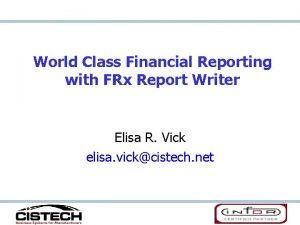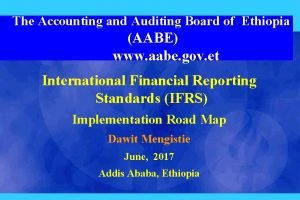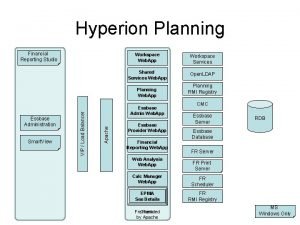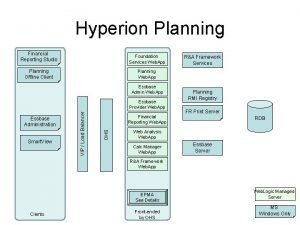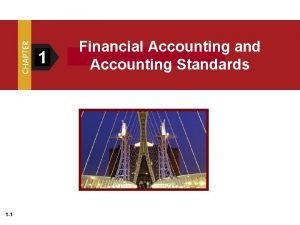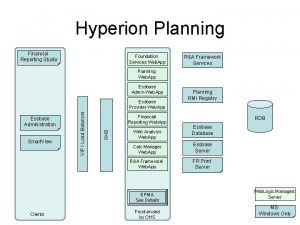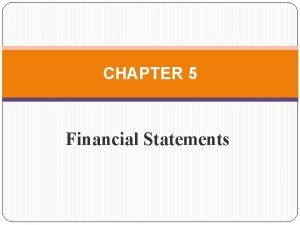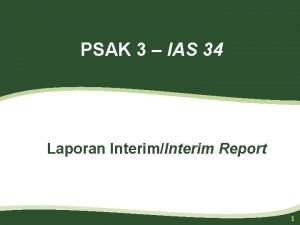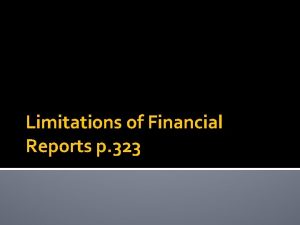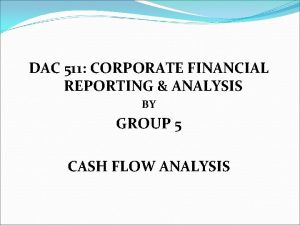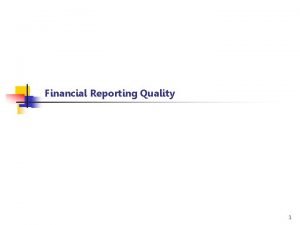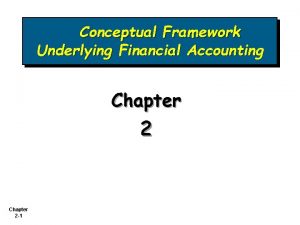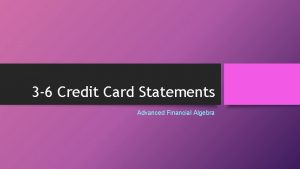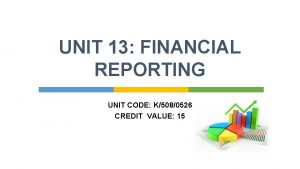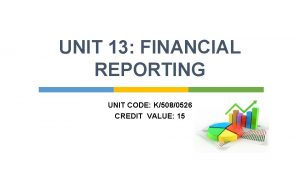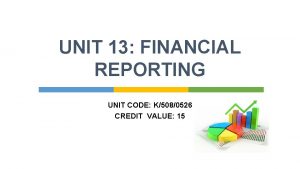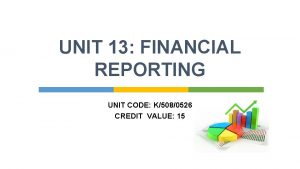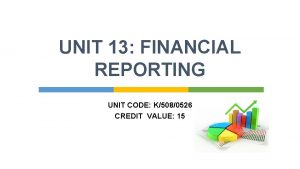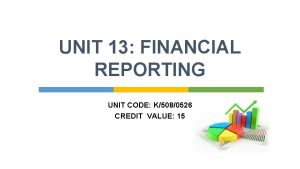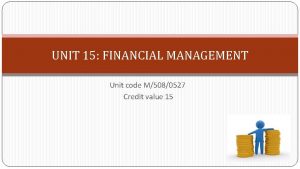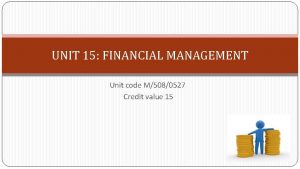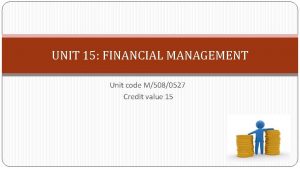UNIT 13 FINANCIAL REPORTING UNIT CODE K5080526 CREDIT



















![REFERENCES § https: //www. accountingtools. com/articles/2017/5/14/fina ncial-statement-analysis [Accessed 25 Sep. 2017]. § https: //www. REFERENCES § https: //www. accountingtools. com/articles/2017/5/14/fina ncial-statement-analysis [Accessed 25 Sep. 2017]. § https: //www.](https://slidetodoc.com/presentation_image_h/144ea795bc89915feb6a475eabb52290/image-20.jpg)
![REFERENCES § https: //www. cleverism. com/financial-statement-analysisintroduction/ [Accessed 25 Sep. 2017]. REFERENCES § https: //www. cleverism. com/financial-statement-analysisintroduction/ [Accessed 25 Sep. 2017].](https://slidetodoc.com/presentation_image_h/144ea795bc89915feb6a475eabb52290/image-21.jpg)
- Slides: 21

UNIT 13: FINANCIAL REPORTING UNIT CODE: K/508/0526 CREDIT VALUE: 15

UNIT 13: FINANCIAL REPORTING § Learning Outcome 2: Interpret Financial Statements

THE BASIC SYLLABUS § 1. Analyse the context and purpose of financial reporting. § 2. Interpret Financial statements § 3. Evaluate financial reporting standards and theoretical models and concepts § 4. Evaluate international differences in financial reporting

LEARNING OUTCOMES §Interpret Financial Statements § P 3: Interpret profit and loss, cashflow and balance statements

OVERVIEW Financial Statement Analysis is a method of reviewing and analyzing a company’s accounting reports (financial statements) in order to gauge its past, present or projected future performance. This process of reviewing the financial statements allows for better economic decision making.

FINANCIAL STATEMENTS § Financial statement provides multiple years of data. Used together analysts can track performance measures across financial statements using several different methods for financial statement analysis, including vertical and horizontal analysis. An example of vertical analysis is when each line item on the financial statement is listed as a percentage of another. Horizontal analysis compares line items in each financial statement against previous time periods. In ratio analysis, line items from one financial statement are compared with line items from another.

FINANCIAL STATEMENTS § Analysts like to know how many times a company can pay off debt with current earnings. Analysts can do this by dividing debt, which comes from the balance sheet, by net income, which comes from the income statement. Likewise, return on assets (ROA) and the return on equity (ROE) compare company net income found on the income statement with assets and stockholders' equity as found on the balance sheet.

Users of Financial Statement Analysis § There a number of users of financial statement analysis. They are: § Creditors. Anyone who has lent funds to a company is interested in its ability to pay back the debt, and so will focus on various cash flow measures. § Investors. Both current and prospective investors examine financial statements to learn about a company's ability to continue issuing dividends, or to generate cash flow, or to continue growing at its historical rate (depending upon their investment philosophies).

Users of Financial Statement Analysis § Management. The company controller prepares an ongoing analysis of the company's financial results, particularly in relation to a number of operational metrics that are not seen by outside entities (such as the cost per delivery, cost per distribution channel, profit by product, and so forth). § Regulatory authorities. If a company is publicly held, its financial statements are examined by the Jamaica Stock Exchange Council (if the company files in Jamaica ) to see if its statements conform to the various accounting standards and the rules of the JSEC.

INTERPRET PROFIT AND LOSS § A profit and loss report, also known as an income statement, shows the profitability of your business over a specific period. It can cover any period of time, but is most commonly produced monthly, quarterly or annually. § A profit and loss report is a useful tool for monitoring business activity.

INTERPRET PROFIT AND LOSS §For business owners, it highlights where their business is succeeding and where it is struggling. Investors will use profit and loss reports to gauge the financial health of a potential investment, or to see what kind of return they are getting on an existing investment.

PROFIT AND LOSS/INCOME STATEMENT § Source: courses. lumenlearning. com

INTERPRET CASHFLOW §A cash flow statement shows how much cash is moving in and out of your business over a certain period of time (i. e. it reflects your 'liquidity'). §Having enough cash available to pay your debts and to buy materials and assets is an important part of business planning. A cash flow statement will quickly tell you if you are likely to have any issues in this area.

CASHFLOW STATEMENT § http: //www. assignmenthelp. net/assignment_help/cash-flow-statement

INTERPRET BALANCE SHEET STATEMENTS §A balance sheet is also called a 'statement of financial position' because it provides a snapshot of your assets and liabilities - and therefore net worth - at a single point in time (unlike other financial statements, such as profit and loss reports, which give you information about your business over a period of time).

INTERPRET BALANCE SHEET STATEMENTS §There are 3 different sections in a balance sheet, represented by the following formula: §Assets – liabilities = owner's equity §It is called a balance sheet because, at any given moment, each side of this equation must 'balance' out.

INTERPRET BALANCE SHEET STATEMENTS §A balance sheet is a summary of all of your business assets (what the business owns) and liabilities (what the business owes). At any particular moment, it shows you how much money you would have left over if you sold all your assets and paid off all your debts (i. e. it also shows 'owner's equity').

BALANCE SHEET /STATEMENT OF FINANCIAL POSITION § https: //courses. lumenlearning. com

REFERENCES § http: //highered. mheducation. com/sites/dl/free/. . . /100964 1/sub_10963_ch 01_002_065. pdf [Accessed 25 Sep. 2017]. § http: //www. bbc. co. uk/schools/gcsebitesize/business/env ironment/stakeholders 1. shtml [Accessed 25 Sep. 2017]. § http: //www. investopedia. com/terms/f/financial-statement -analysis. asp
![REFERENCES https www accountingtools comarticles2017514fina ncialstatementanalysis Accessed 25 Sep 2017 https www REFERENCES § https: //www. accountingtools. com/articles/2017/5/14/fina ncial-statement-analysis [Accessed 25 Sep. 2017]. § https: //www.](https://slidetodoc.com/presentation_image_h/144ea795bc89915feb6a475eabb52290/image-20.jpg)
REFERENCES § https: //www. accountingtools. com/articles/2017/5/14/fina ncial-statement-analysis [Accessed 25 Sep. 2017]. § https: //www. business. qld. gov. au/runningbusiness/finances-cash-flow/managing-money/financialstatements-forecasts/ [Accessed 25 Sep. 2017].
![REFERENCES https www cleverism comfinancialstatementanalysisintroduction Accessed 25 Sep 2017 REFERENCES § https: //www. cleverism. com/financial-statement-analysisintroduction/ [Accessed 25 Sep. 2017].](https://slidetodoc.com/presentation_image_h/144ea795bc89915feb6a475eabb52290/image-21.jpg)
REFERENCES § https: //www. cleverism. com/financial-statement-analysisintroduction/ [Accessed 25 Sep. 2017].
 Code commit code build code deploy
Code commit code build code deploy This can be avoided by giving credit where credit is due.
This can be avoided by giving credit where credit is due. Frx report designer
Frx report designer Audit board of ethiopia
Audit board of ethiopia The purpose of financial statements
The purpose of financial statements What is financial reporting studio?
What is financial reporting studio? Essbase financial reporting studio
Essbase financial reporting studio Us gaap conceptual framework
Us gaap conceptual framework American accounting standards
American accounting standards What is financial reporting studio?
What is financial reporting studio? Fge financial management
Fge financial management Cbd financial reporting framework
Cbd financial reporting framework Ias 34 interim financial reporting
Ias 34 interim financial reporting Project management financial reporting
Project management financial reporting Normalised earnings limitations
Normalised earnings limitations Direct vs indirect cash flow
Direct vs indirect cash flow Chapter 2 conceptual framework for financial reporting
Chapter 2 conceptual framework for financial reporting International financial reporting standards 9
International financial reporting standards 9 Limitations of financial reporting
Limitations of financial reporting Fair value historical cost
Fair value historical cost 3-5 credit cards financial algebra
3-5 credit cards financial algebra Best financial credit union
Best financial credit union


